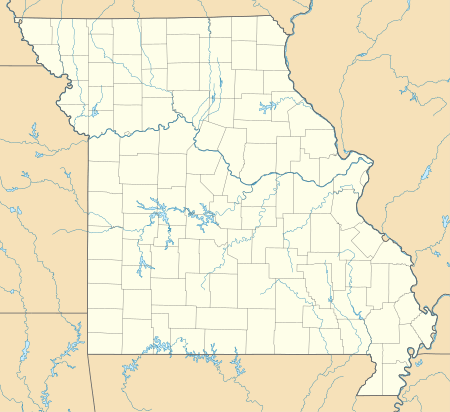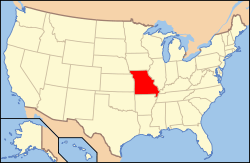Meramec State Park
Meramec State Park is a public recreation area located near Sullivan, Missouri, about 60 miles from St. Louis, along the Meramec River.[4] The park has diverse ecosystems such as hardwood forests and glades. There are over 40 caves located throughout the park, the geology of which is a mixture of limestone and dolomite. The most famous is Fisher Cave, located near the campgrounds. The park borders the Meramec Conservation Area.
| Meramec State Park | |
|---|---|
A stalactiflat in Fisher Cave | |
 Location in Missouri  Meramec State Park (the United States) | |
| Location | Franklin, Crawford, Washington, Missouri, United States |
| Coordinates | 38°12′24″N 91°6′9″W |
| Area | 6,896.33 acres (27.9085 km2)[1] |
| Elevation | 571 ft (174 m)[2] |
| Established | 1927[3] |
| Visitors | 676,859 (in 2017)[1] |
| Governing body | Missouri Department of Natural Resources |
| Website | Meramec State Park |
Meramec State Park Lookout House/Observation Tower | |
| Nearest city | Sullivan, Missouri |
| Area | Less than one acre |
| Built | c. 1934 |
| Built by | CCC; NPS |
| Architectural style | Rustic |
| MPS | ECW Architecture in Missouri State Parks 1933-1942 TR |
| NRHP reference No. | 85000530 |
| Added to NRHP | February 28, 1985 |
Meramec State Park Pump House | |
| Nearest city | Sullivan, Missouri |
| Area | Less than one acre |
| Built | 1934 |
| Built by | CCC; NPS |
| Architectural style | Rustic |
| MPS | ECW Architecture in Missouri State Parks 1933-1942 TR |
| NRHP reference No. | 85000531 |
| Added to NRHP | February 28, 1985 |
Meramec State Park Shelter House | |
| Nearest city | Sullivan, Missouri |
| Area | Less than one acre |
| Built | 1935 |
| Built by | CCC; NPS |
| Architectural style | Rustic |
| MPS | ECW Architecture in Missouri State Parks 1933-1942 TR |
| NRHP reference No. | 85000532 |
| Added to NRHP | February 26, 1985 |
Meramec State Park Beach Area Historic District | |
| Nearest city | Sullivan, Missouri |
| Area | Less than one acre |
| Built by | National Park Service |
| Architectural style | Rustic |
| MPS | ECW Architecture in Missouri State Parks 1933-1942 TR |
| NRHP reference No. | 91001772 |
| Added to NRHP | December 6, 1991 |
History
The park was acquired by the state in 1927, then saw active development by the Civilian Conservation Corps (CCC) between 1933 and 1935. At that time, trails were laid out and numerous buildings constructed including a dining hall, recreation hall, concession building, and shelters.[5]
In the late 1970s, as part of the Meramec Basin Project, the U.S. Army Corps of Engineers began work on a dam in the park to impound the river. The resulting reservoir would have permanently flooded much of the park and imperiled many different species, including the endangered Indiana bat. However, in response to direct citizen action against the dam, the project was halted, marking a victory for the environmental movement.[6]
Historic sites
Three surviving CCC-era structures were added to the National Register of Historic Places in 1985:
- Meramec State Park Lookout House/Observation Tower: The rustic-style stone and trussed timber octagonal lookout tower was built about 1934.[5]:339
- Meramec State Park Pump House: The rustic-style stone pump house (well house) on the Lodge Trail has a medium-pitched front-gable roof with small cupola. It was built in 1934.[5]:343
- Meramec State Park Shelter House: The rustic-style shelter house on the Lodge Trail measures 12 feet by 16 feet and has a hipped roof supported by heavy wooden posts and brackets. It was built in 1935.[5]:350
In 1991, the Meramec State Park Beach Area Historic District was also added to the list. The historic district encompasses four contributing buildings, three contributing structures, and one contributing object. They include the picnic shelter, stone restrooms, water fountain, pump house, and stone steps[7]:5
The bottom southeast corner of the park includes the old Hamilton Ironworks, after which the Ozarks fiddle tune Hamilton Ironworks is named.[8][9] The Hamilton Iron Works Trail has interpretive signage about the history the blast furnace that once operated "around the clock, seven days a week."[10]
Activities and amenities
In addition to cave tours, the park offers hiking trails, fishing, swimming and boating on the Meramec River, and a campground. The visitor center houses an exhibit hall with a video presentation and information about the history and ecology of the area.[11]
References
- "Meramec State Park: Data Sheet" (PDF). Missouri Department of Natural Resources. November 2017. Retrieved May 6, 2018.
- "Meramec Park Lake". Geographic Names Information System. United States Geological Survey.
- "State Park Land Acquisition Summary". Missouri State Parks. Retrieved August 14, 2015.
- "Meramec State Park". Missouri Department of Natural Resources. Retrieved September 9, 2014.
- "ECW Architecture in Missouri State Parks 1933-1942 Thematic Resources" (PDF). National Register of Historic Places Nomination Form. Missouri Department of Natural Resources. Retrieved October 19, 2015.
- Watkins, Connor (2006). "The Meramec Basin Project: A Look Back 25 Years Later". Conor Watkins' Ozark Mountain Experience. Retrieved 2010-10-24.
- Bonnie Stepenoff (June 1991). "Meramec State Park Beach Area Historic District" (PDF). National Register of Historic Places Inventory Nomination Form. Missouri Department of Natural Resources. Retrieved December 1, 2016. (includes 8 photographs from 1991)
- Lohraff, Kevin (2009). Map: Fisher Cave, Old Hamilton Ironworks. Hiking Missouri. Human Kinetics. p. 139. ISBN 9780736075886.
- Beisswenger, Drew; McCann, Gordon (2008). Ozarks Fiddle Music. Mel Bay Publications. p. 186. ISBN 9780786677306.
Cecil learned “Hamilton Ironworks” from Gene, who learned it in the 1950s from Roy Wooliver.
- "Trails at Meramec State Park". Missouri Department of Natural Resources. Retrieved September 9, 2014.
- "Visitor Center at Meramec State Park". Missouri Department of Natural Resources. Retrieved September 9, 2014.
External links
- Meramec State Park Missouri Department of Natural Resources
- Meramec State Park Map Missouri Department of Natural Resources

